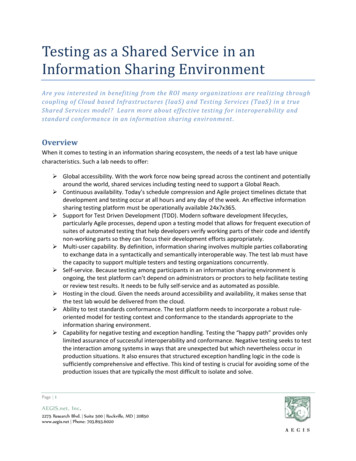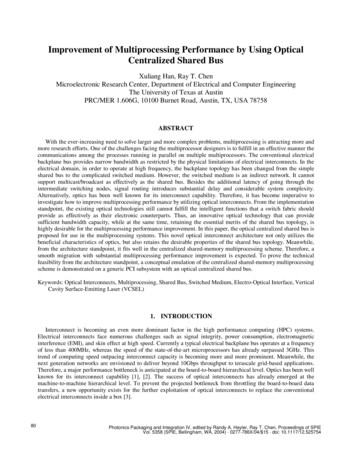
Transcription
Testing as a Shared Service in anInformation Sharing EnvironmentAre you interested in benefiting from the ROI many organizations are realizing throughcoupling of Cloud based Infrastructures (IaaS) and Testing Services (TaaS) in a trueShared Services model? Learn more about effective testing for interoperability andstandard conformance in an information sharing environment .OverviewWhen it comes to testing in an information sharing ecosystem, the needs of a test lab have uniquecharacteristics. Such a lab needs to offer: Global accessibility. With the work force now being spread across the continent and potentiallyaround the world, shared services including testing need to support a Global Reach. Continuous availability. Today’s schedule compression and Agile project timelines dictate thatdevelopment and testing occur at all hours and any day of the week. An effective informationsharing testing platform must be operationally available 24x7x365. Support for Test Driven Development (TDD). Modern software development lifecycles,particularly Agile processes, depend upon a testing model that allows for frequent execution ofsuites of automated testing that help developers verify working parts of their code and identifynon-working parts so they can focus their development efforts appropriately. Multi-user capability. By definition, information sharing involves multiple parties collaboratingto exchange data in a syntactically and semantically interoperable way. The test lab must havethe capacity to support multiple testers and testing organizations concurrently. Self-service. Because testing among participants in an information sharing environment isongoing, the test platform can’t depend on administrators or proctors to help facilitate testingor review test results. It needs to be fully self-service and as automated as possible. Hosting in the cloud. Given the needs around accessibility and availability, it makes sense thatthe test lab would be delivered from the cloud. Ability to test standards conformance. The test platform needs to incorporate a robust ruleoriented model for testing context and conformance to the standards appropriate to theinformation sharing environment. Capability for negative testing and exception handling. Testing the “happy path” provides onlylimited assurance of successful interoperability and conformance. Negative testing seeks to testthe interaction among systems in ways that are unexpected but which nevertheless occur inproduction situations. It also ensures that structured exception handling logic in the code issufficiently comprehensive and effective. This kind of testing is crucial for avoiding some of theproduction issues that are typically the most difficult to isolate and solve.Page 1AEGIS.net, Inc.2275 Research Blvd. Suite 500 Rockville, MD 20850www.aegis.net Phone: 703.893.6020
Detailed reporting. The ideal test platform doesn’t simply report success or failure of a test. Itprovides highly detailed statistics and troubleshooting information to help developers pinpointthe root cause of defects, correct them efficiently, and re-test quickly. For example, it’s thedifference between knowing your car won’t start without knowing the reason, and insteadknowing immediately that the starter has failed and needs to be replaced. Standardized test data. Effective interoperability testing requires a sufficiently large sample oftest data that allows for proper exercise of all relevant aspects of the interoperability among thetested systems. For example, interoperability test data in the healthcare domain demandsmillions of individual “synthetic patient” data records for simulating a range of medical eventsacross multiple systems and organizations. Communities of Interest. The shared testing environment can amplify its effectiveness byoffering a mechanism for organizing Communities of Interest that attract organizations testingagainst the same standards and information domains. It allows these organizations to sharetheir challenges and lessons learned, benefitting from the aphorism, “a rising tide lifts all boats.”The Importance of InteroperabilityInformation sharing standards provide a common language and set of expectations that enableinteroperability among message-based systems. Ideally, data exchange standards should permit data tobe shared among various kinds of users regardless of application or application vendor. Facilitatinginteroperability among multiple systems involves the development of information exchange gatewaysand adapters. Gateways provide a “bridge” from one Organization (system) to another, enabling thesecure transfer of information and allowing gateway-to-gateway communication. Every system musthave a gateway service to exchange information with another system. Adapters attach to the gatewaysacting as a translator for both the gateway and application it represents for the message that is sent andreceived during a transaction. These gateways include the necessary interoperability standards toenable a secure and accurate transaction from one system to another.Standards-based, interoperable solutions are necessary for effective and secure information exchange.As an example from the health care industry, a significant percent – some estimates are as high as 85% –of the information needed to care for a patient at some point needs to cross enterprise boundaries;interoperability is mandatory to ensure that information flows readily and securely.1Additionally, interoperability provides an effective tool in combating fraud, waste, and abuse (FW&A) –an area that inflicts staggering costs on already burdened systems in various disciplines. Medicare andMedicaid FW&A costs taxpayers billions of dollars each year; beyond representing an economic concern,fraud risk affects all aspects of compliance, including patient safety.2 FW&A can be greatly reduced1“Breaking Barriers to Interoperable Health Care.” Government Health IT Conference and Exhibition. HIMSS. rability.aspx2Testimony of Daniel R. Levinson, Inspector General, U.S. Department of Health & Human Services. March 30211DL1.pdfPage 2AEGIS.net, Inc.2275 Research Blvd. Suite 500 Rockville, MD 20850www.aegis.net Phone: 703.893.6020
when medical claims data can be linked to an Electronic Health Record (EHR) and exchanged betweenthe payer and provider. Utilizing advanced analytics, a provider can detect certain types of fraud, waste,and abuse before administering a procedure. The payer can evaluate the attached medical claim andeither validate and pay the claim or invalidate the claim.3 Ensuring interoperability between the payerand provider significantly prevents fraudulent claims within the health care system, lowering health carecosts to providers.Ensuring interoperability impacts decision making as well. For example, a major component of healthinformation interoperability centers around the accuracy of information and content sent between twoor more health care systems. Providing immediate patient information and medical data to health careproviders mitigates the risk of performing unnecessary medical procedures during a patient encounter.Doctors are given the freedom of abundant and accurate patient data securely exchanged among healthcare systems, to identify and perform necessary procedures. The end result is improved quality of careand avoidance of unnecessary costs. Similar benefits apply to interoperability in every domain fromfinance to law enforcement to logistics.Why is Testing for Interoperability So Hard?Organizations must have a solid understanding of Technical (syntactic), Semantic and ProcessInteroperability concepts to truly grasp the challenges and barriers to success. Technical (syntactic)Interoperability allows computers to reliably exchange data. This is accomplished with messagingprotocols and data formats. Semantic Interoperability allows computers to unambiguously andconsistently determine the meaning of the data for presentation and decision support – that is, theinteroperating systems interpret the data in the same way. This can be accomplished with the use ofstandardized terminologies (e.g., ICD-10, SNOMED, etc.). Process Interoperability allows computers toexchange data and track workflows as records move between organizations. This is accomplished withstandardized business process notation or workflow protocols.AEGIS’ experience in health information interoperability and conformance testing has revealed keyinsights in to what makes it so difficult. The nature of interoperability means there will always beexternal constraints affecting any one system’s testing. As the cliché goes, “It takes two to Tango.”Interoperability involves at least two systems that need to remain in step with each other as theyexchange and interpret shared information. A change to one exchange partner’s system could affectinteroperability with all its other partners. Decisions made by one organization’s CIO can impact thatorganization’s interoperability with many other organizations. The bottom line is that interoperabilitytesting cannot be viewed in terms of a point in time – because once that point in time has passed,3Hanson, Susan P. “Fraud Control: New Tools, New Potential.” Journal of AHIMA 77, no.3 (March 2006): c/documents/ahima/bok1 030850.hcsp?dDocName bok1 030850Page 3AEGIS.net, Inc.2275 Research Blvd. Suite 500 Rockville, MD 20850www.aegis.net Phone: 703.893.6020
interoperability can no longer be assured. One of the hardest aspects to understand when it comes tointeroperability testing is that is must be continuous. Only when testing for continuous interoperabilityis in place can stakeholders be assured that their information sharing initiatives will likewise carry onwithout interruption. Continuous interoperability requires a robust automated testing approach andtools that focus on that important outcome.A Vision for Effective Interoperability TestingThe testing needs to begin early. If interoperability testing is not performed until a system is preparingto join an information exchange ecosystem, the probability of encountering serious defects is high.Interoperability testing needs to begin during the earliest development stages of a new system orrelease. The testing platform needs to be made available to the development team to use when theyneed it. Given the nature of distributed development teams and Agile development processes, such aplatform needs to be available from anywhere in the world and any time of day or night. A cloud-basedservice is ideal for fulfilling this need.The test platform needs to truly provide a production-like environment for effective interoperabilitytesting. Such a platform needs to implement instances of information exchange gateways – not just‘stubs’ or placeholders for those systems. Why? Because such placeholders inevitably involve certainshort cuts and assumptions that don’t necessarily represent how the various systems interoperate in thereal world. This can easily lead to invalid testing results obviating the effectiveness of the testing.Considering all the development teams working to produce interoperable solutions, this commontesting platform that represents the full information sharing ecosystem needs to be able to supportmultiple development teams testing concurrently without adversely affecting other teams’ results.Testing can’t become a bottleneck to the development team’s velocity. Therefore, each team needs tobe able to handle its own testing on the platform in a self-serve manner. Ideally, the test platform allowsthe development team and/or their testing body to create test cases or select from existing standardsbased tests and repeatedly execute their selected suite of tests in an automated fashion.At the same time, testing can’t be limited to positive or “happy path” testing – that is, testing to ensuremerely that the system does what it is supposed to do. In production, unexpected things happen and ifsystems don’t handle those situations (exceptions) gracefully, they are vulnerable to failing in dramaticways such as incurring a sustained outage or exposing secure information. Therefore, interoperabilitytesting, like all software testing, needs to include negative testing. Negative testing in message-basedinformation exchange addresses scenarios such as malformed messages. Testing such situations andidentifying related defects during testing is critical because these are among the most difficult problemsto chase down when they occur in production.Page 4AEGIS.net, Inc.2275 Research Blvd. Suite 500 Rockville, MD 20850www.aegis.net Phone: 703.893.6020
Finally, effective interoperability testing needs to not only indicate defects, but also provide sufficientsupporting details for the development team top efficiently identify the root cause, correct the problem,and re-test it. This is the kernel of TDD. Testing environments offering highly visible results, drill-downcapability in to message traffic at the source of the defect, and pointers to the problem(s) candramatically shorten the troubleshooting cycle and speed the development and delivery of the system into production. A related feature of the testing platform is a sufficient quantity of standardized test dataavailable to the systems under test (SUT) that allow for exercising all aspects of a transaction betweensystems. Developing correct test data in an interoperability testing environment requires careful analysisand design of that data as well as a configuration management approach that protects its integrity.Interoperability and standards conformance testing is not easy, but with the right testing tools andenvironment it doesn’t need to be hard either.About AEGISAEGIS.net, Inc. (AEGIS) is a CMMI-Maturity Level 3 rated (CMMI-DE
tested systems. For example, interoperability test data in the healthcare domain demands millions of individual synthetic patient data records for simulating a range of medical events across multiple systems and organizations. Communities of Interest. The shared testing environment can amplify its











